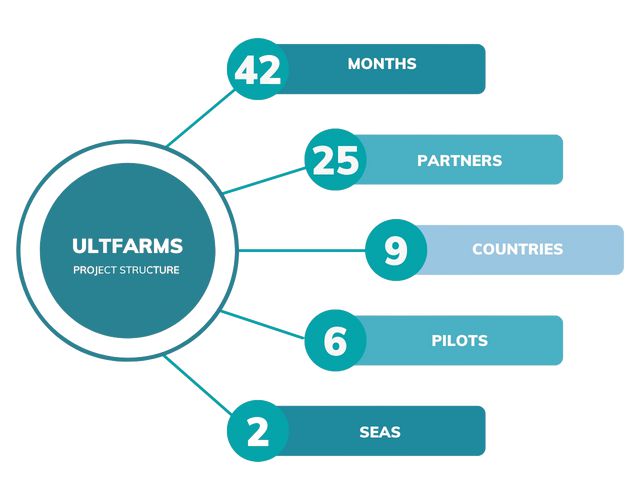 ULTFARMS (Circular Low Trophic Offshore Aquaculture in Wind Farms and Restoration of Marine Space) was approved under the Horizon Europe Ocean Mission call titled Lighthouse in the Baltic and the North Sea basins - Low impact marine aquaculture and multi-purpose use of marine space. ULTFARMS is a 42 months project that has started on January 1st, 2023, and ends on June 30th, 2026. It is lead by Deltares, an independent institute for water and subsurface research based in the Netherlands. The consortium of the project consists of 25 members from 9 different countries.>
ULTFARMS (Circular Low Trophic Offshore Aquaculture in Wind Farms and Restoration of Marine Space) was approved under the Horizon Europe Ocean Mission call titled Lighthouse in the Baltic and the North Sea basins - Low impact marine aquaculture and multi-purpose use of marine space. ULTFARMS is a 42 months project that has started on January 1st, 2023, and ends on June 30th, 2026. It is lead by Deltares, an independent institute for water and subsurface research based in the Netherlands. The consortium of the project consists of 25 members from 9 different countries.>
ULTFARMS will bring together stakeholders from across the value chains of OWF and LTA to ensure that environmentally sound, low-carbon, and safe LTA products are produced from design to commercialization. New cultivation structures, grow-out systems, and eco-friendly design measures will be advanced through the project. Through integrated monitoring and management platforms such as the HiSea service platform and by drawing on existing open databases and operational forecasting systems such as CMEMS and SeaDATANET, the planning and operation of LTAs will be effectively supported through an enhanced technical service.
ULTFARMS will offer services to aquaculture producers for monitoring and minimizing diseases and alien species, managing inputs, optimizing sustainable production, and demand management including risk analysis. Furthermore, the project will share lessons learned and innovations developed through comprehensive communication and dissemination activities, which will be underpinned by the active involvement of five Associate Regions (ARs) throughout the project.
ULTFARMS will generate a profitable, sustainable, and ecological production chain of low- trophic level species, such as seaweed and molluscs, in offshore wind farms located in the North Sea and Baltic Sea. This project has received 9.6 million euros from the European Union's Horizon research and innovation programme and will help to boost the self- consumption of these products in Europe while reducing the carbon footprint of their production.

This project has received funding from the European Union's Horizon Europe research and innovation programme under Grant Agreement No 101093888. Views and opinions expressed are however those of the author(s) only and do not necessarily reflect those of the European Union. Neither the European Union nor the granting authority can be held responsible for them.










